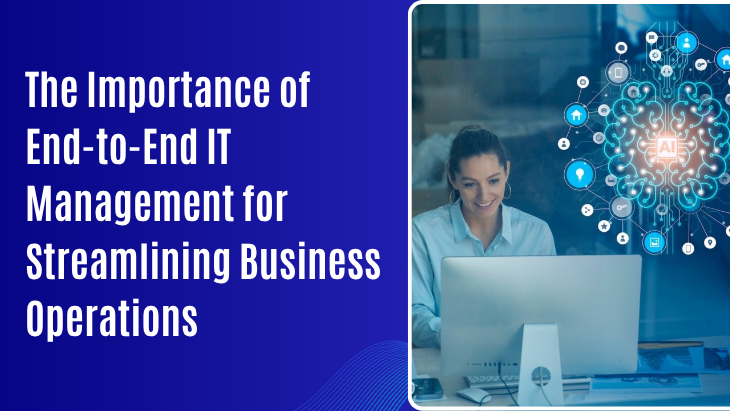In today’s digitally driven landscape, the efficiency of a business is often measured by how well it manages its technology. From small startups to large enterprises, end-to-end IT management plays a crucial role in ensuring smooth operations, data security, and improved productivity. Integrated IT & Hardware Solutions This approach covers every aspect of a company’s IT ecosystem from infrastructure setup and hardware provisioning to network management, cybersecurity, software updates, and support services. Companies that adopt end-to-end IT & hardware solutions obtain a competitive advantage by breaking down silos, decreasing downtime, and improving their capacity to scale.
Knowing the Idea of End-to-End IT Management
End-to-end IT management is an umbrella and integrated way of managing all the IT-related aspects within a company. Rather than dealing with hardware, software, networking, and support as individual things, companies deal with them as a single interdependent entity. This overarching perspective facilitates the detection of inefficiencies, data security, and workflow streamlining. When integrated IT & hardware solutions form part of the framework, organizations are able to see their IT strategy aligned with business objectives, so that technology acts as a backbone instead of a bottleneck.
The Role of Integrated IT & Hardware Solutions
Integrated IT & hardware offerings combine servers, storage, workstations, and networking hardware with sophisticated software systems and support tools. The combination creates a stable and uniform IT ecosystem, minimizes incompatibility problems, and simplifies troubleshooting. Sourcing all of them from a single source or keeping them under a common strategy, organizations can reduce operational expenditure while increasing system performance and availability.
Enhanced Operational Effectiveness and Workflow Automation
One of the most visible advantages of end-to-end IT management is enhanced operational effectiveness. With the properly integrated IT infrastructure, organizations can automate routine jobs, minimize manual errors, and achieve quicker execution of day-to-day operations. Automated tasks such as data backup, patching updates, and monitoring the network can be performed, allowing the in-house teams to dedicate their time to tactical projects. Integrated IT & hardware solutions are an important part of this automation process, providing smooth integration of software applications and the hardware that supports them.
Improved Security and Compliance
Cyber threats are increasing in terms of complexity and frequency, and IT security is one area that all organizations need to be concerned with. End-to-end IT management encompasses proactive security measures that cover the whole IT infrastructure — from firewalls and endpoint protection to secure cloud access and encrypted communication. Integrated IT & hardware solutions play their part in this strong defense by making sure that all devices and applications follow uniform security standards. Businesses also find it easier to stay compliant with industry regulations when they possess total visibility and control over their IT systems.
Scalability and Future-Proofing Business Operations
As businesses expand and mature, their IT requirements shift. End-to-end management of IT provides the agility to scale IT infrastructure without stopping current operations. Whether a company is expanding to new premises, hiring more staff, or launching digital offerings, integrated IT & hardware solutions enable fast adaptations. This scalability makes companies agile and can react to market needs without the exorbitant costs and time involved in upgrading IT piecemeal. Future-proofing also refers to the fact that systems are aligned to support new technologies such as AI, IoT, and edge computing.
Cost Savings and Resource Optimization
It costs money to manage IT end-to-end, but this ultimately results in long-term savings. Companies save money by eliminating the need for multiple suppliers, preventing expensive downtimes, and reducing the dangers of data breaches or hardware failure. Integrated IT & hardware solutions simplify procurement and maintenance procedures to allow resources to be used efficiently. IT personnel can also work more effectively using centralized tools and dashboards, eliminating time-consuming tasks and minimizing the requirement for frequent troubleshooting.
Centralized Monitoring and Performance Management
With end-to-end IT planning, businesses enjoy centralized monitoring systems delivering real-time visibility into the performance of their entire infrastructure. From server health and network speed to storage utilization and user access, IT staff can identify anomalies and take action rapidly before issues get out of control. Integrated IT & hardware solutions enable it by making all parts of the IT ecosystem talk to one another, presenting a single source of truth for system administrators. Centralized provides better responsiveness, avoids outages, and provides a more stable operating environment.
Improved Support and User Experience
Trustworthy IT systems have a direct effect on the satisfaction and productivity of employees and customers. End-to-end IT management provides the assurance that user problems are fixed rapidly, helpdesk requests are solved quickly, and downtime is reduced. With integrated IT & hardware solutions, support staff have greater insight into user environments, so they can better diagnose problems and deliver quicker fixes. Employees, meanwhile, have less disturbance, can work more productively, and are more enabled by technology that simply works. Happy workers result in improved customer service, which is crucial for long-term success.
Conclusion
With a business world where time is money and growth is fueled by technology, end-to-end IT management is not a luxury it's necessary. With integrated IT & hardware solutions, companies set themselves up for long-term success via streamlined operations, improved security, cost savings, and scalability. Praise-Group Investing in an integrated IT strategy guarantees every system plays nicely together, serves business goals, and is ready to support whatever comes next. For any business that wants to maintain competitiveness and responsiveness in a digital age, adopting holistic IT management is a strategic investment that yields benefits far greater than the technology stack.





Leave a reply